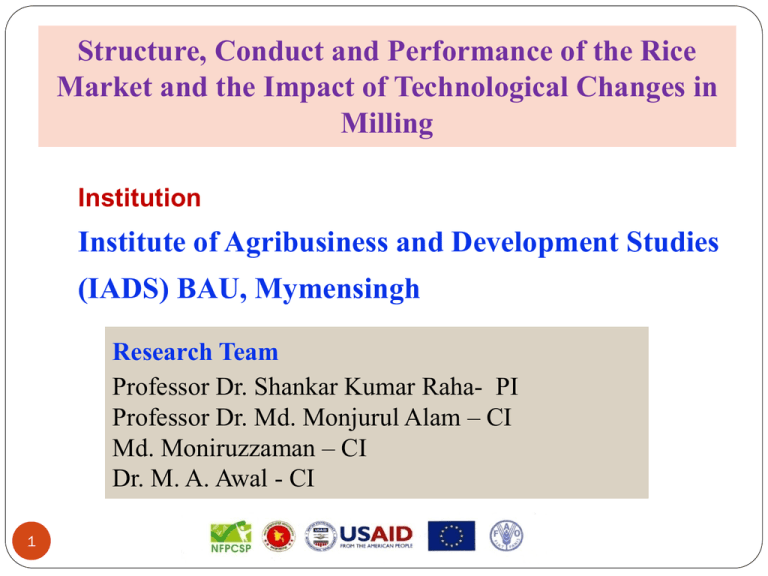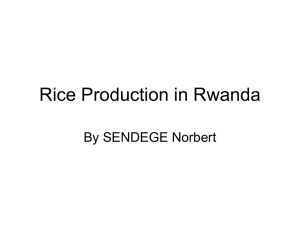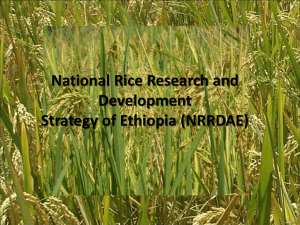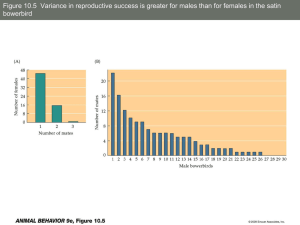
Structure, Conduct and Performance of the Rice
Market and the Impact of Technological Changes in
Milling
Institution
Institute of Agribusiness and Development Studies
(IADS) BAU, Mymensingh
Research Team
Professor Dr. Shankar Kumar Raha- PI
Professor Dr. Md. Monjurul Alam – CI
Md. Moniruzzaman – CI
Dr. M. A. Awal - CI
1
Objectives of the Research Project
1. To provide evidence and provide new evidence on rice market
structure, conduct and performance in Bangladesh and
To analyze the impacts of technological changes in the rice
milling sector on employment, financial viability of rice
mills, market concentration, rice quality, and cost of milling
2. To construct detail estimates of costs and margins for key
agents along the rice marketing chain in Bangladesh and
to analyze market integration between domestic and
international markets.
3. To suggest policy implications for improving market structure,
conduct and performance.
2
Methodology
The study will be conducted by adopting the structure,
conduct and performance approach (SCP). This
technique was first formalized by Mason (1939) and his
detailed case study approach was modified by Bain
(1951).
Market structure
3
Market conduct
Market performance
Methodology (Contd.)
Area
District
Faria
Bepari Aratdar
Miller Aratdar Aratdar
cum
wholesal
er
cum
wholesale
r
Paddy
wholesal
er
Wholesal
er cum
retailer
Retailer Importer
Milled rice
Key agents
Dinajpur
Surplus
Rangpur
Naogaon
Bogra
Sherpur
Comilla
Kushtia
Deficit
Sylhet
Khulna
Dhaka
Noakhali
Chittagong
Total
4
15
0
3
2
0
1
16
0
0
0
2
0
39
17
13
27
15
1
3
2
7
2
10
4
5
134
13
16
21
6
32
3
7
0
7
1
5
2
112
20
10
20
8
15
2
25
2
2
2
2
2
110
0
3
1
0
4
0
0
0
6
16
0
0
30
6
7
5
2
0
0
0
0
4
0
0
0
24
5
3
10
15
8
10
17
11
8
10
12
20
129
8
4
0
0
2
14
4
9
9
5
6
5
66
11
13
11
7
8
1
8
5
3
11
10
15
103
2
3
5
Methodology (Contd.)
(a) Estimation of market concentration
4 firm concentration ratio, Entropy index, and Gini coefficient.
(b) Financial viability of the mills was assessed by using NPV, IRR, BCR.
(c) Calculation of marketing costs and margins was done by using
standard formula (Kohls and Uhl, 2005)
(d) Market integration
Market integration was examined by applying co-integration
method developed by Engle and Granger
Data: monthly wholesale price from 1990 to 2011(domestic mkts).
Data: monthly export price of Thailand, Vietnam, and Eastern
India converted into import parity price (1975 to 2011)
5
Overview of the structure, conduct and performance of rice
market in Bangladesh
Researcher Year
Findings
Farruk,
1970 He labeled the markets as oligopolistic as well as
M.O.
oligopsonistic but close observation of the functioning of this
structure in the different markets did not support the
prevalence of unethical market conduct.
Islam et al 1987 The net return to all the functionaries in the channels was
low due to intense competition. Excessive profit of the
functionaries was not found. Capacity utilization of the mills
varied from 40% to 65% at the peak period and 20% to 48%
in low volume months.
Chowdhury 1992 The market was found atomistic on both sides. The aratdar, N.
cum wholesalers were powerful in the rice market as they
handled about 80% -90% of all rice. No excessive
concentration was found in rice milling industry.
6
Overview of the structure, conduct and performance of rice
market in Bangladesh contd.
Rahman, 1998 No collusion among the sellers and buyers were
S.M.S.
observed but the millers complained about aratdars’
collusive activity.
Siddique 2010 He found low level of concentration in the rice milling,
Identified a no. of requirements for the entry.
, M.A.B.
The millers are price taker not price maker.
Performance of the rice milling industry was not
good in terms of capacity utilization.
Maximum mills are running with decades old
machines.
7
Structure, conduct and performance of paddy market in Bangladesh
4 firm concentration (%)
90 5.4.1Buyer concentration in paddy markets
80
70
60
50
40
30
20
10
0
8
Markets
5.4.2 Entry barrier
In fact there is no barrier except arrangement of requisite capital
5.4.3 Degree of product differentiation (paddy)
No deliberate effort is made to make the paddy differentiated in the
market.
5.4.4 Distribution of market information
No formal system exist for dissemination of market information.
Paddy traders collect market information through their own effort.
5.5 Conduct at paddy market -3
5.6 Performance of paddy market
Paddy market is operating smoothly throughout the country;
Millers are getting paddy as much they need, though farmers are not
getting reasonable price for their paddy.
Farmers’ perspective, paddy market is not running in favour of them.
9
Market structure, conduct and performance of rice
milling industry
5.7 Dimensions of market structure (4)
5.7.1 Seller concentration in rice mill industry
Measure
CR4
Entropy Index , (E)
Gini –Coefficient
Seller concentration in rice mills
0.69 %
3.60 ,Log n =3.66
0.2436
5.7.2 Degree of product differentiation
5.7.3 Entry barrier
Lack of utilities
Skilled manpower
Tough competition
10
Sufficient capital
Suitable site
5.8 Market conduct
5.8.1 Price Policies
Selling price of rice is set independently
Automatic rice mill owners are in better position in negotiation
for setting price.
In the case of husking and semi-automatic mills buyers are
more powerful.
5.8.2 Product Policy
With the changing of milling technology, millers are capable to process rice
according their own choice and also to buyer’s choice
Sometimes the millers supply rice with labeling as per direction of traderbuyers.
11
5.8.3 Policies aimed at coercing rivals
No evidence of predatory and/or exclusionary tactics adopted
by the established firms in rice market.
5.9 Performance-Dimensions
Capacity utilization (%)
Capacity utilization of rice mills
58
56
54
56.24
54.45
52
51.78
50
48
Automatic
Semi-automatic
Rice mill
Size of selling cost
Product quality
Progressiveness of the industry
Employment position
Discrimination by sex
12
Husking
Impact of technological changes in rice milling
Paddy Separator
Rice shifter
13
De-stoner
Silky polisher
Cone Polisher
Colour sorter
Modern Rice mill Equipment
Impact of technological changes in rice milling
Table 6.1: Milling cost and profit by different types of rice mill
Type of rice
mill
Husking
SemiAuto*
SemiAuto**
Auto rice
mill*
Auto rice
mill**
14
cost of
paddy
(Tk.)
Milling
cost
(Tk./ton
of rice)
Total
cost
(Tk.)
Byproduct
Total
return
(Tk.)
Profit
(Tk.)
Whole
rice
recovery
%
Rice
24300
2601
26901
27000
2230
29230
2329
65
25427
2943
28370
28500
2414
30914
2544
66.25
26016
3452
29468
30000
3448
33448
3980
64.75
25177
2563
27740
30000
3478
33478
5738
67.5
26361
3070
29431
32000
3712
35712
6281
66
*Without modern equipment
**With modern equipment
Return (Tk.)
Table 6.2. Employment in different rice mills
Type of rice
mill
Husking
Semi-Auto
Semi-Auto
Auto rice
mill
Auto rice
mill (with
modern
equipment)
15
Labour,
Tk/ton of
paddy
Staff cost,
Tk/ton of
paddy
403
403
483
147
168
216
100
116
173
101
Employment
Labour,
Labour,
man-hr/
manton of
days/yr
paddy
14.17
2232
14.17
2274
15.67
3015
3.20
3120
3.95
5925
Staff,
manhr/ton of
paddy
6.95
9.13
4.50
5.99
Staff,
mandays/yr
4.14
6205
1095
1095
1460
5840
Financial viability of the rice mills
Type of mill
IRR
NPV(‘000Tk.)
at 10%
BCR
(at 10%)
Husking rice
mill
18.45%
Semi-auto rice
mill
25.23%
418
1.002
10325
1.046
Auto-rice mill
117471
1.063
16
32.54%
Farmer
Faria
Aratdar-cum-wholesaler
Bepari
Procurement
centre
Rice miller
Aratdar
Aratdar-cum-wholesaler
Paddy processor
Wholesaler
Wholesaler-cum-retailer
Retailer
Government
procurement
Consumer
Figure 5.1: Typical Marketing Channels of Paddy/ Rice in Bangladesh
17
Marketing margins of paddy/rice for different actors
(for 1 quintal of rice /and equivalent amount of paddy)
2000
1800
1600
Retailer
196.51
Wholesaler cum
retailer
Wholesaler
261.53
1400
216.02
1200
27.81
1000
800
31.9
144.91
849.98
600
145.16
7.81
400
430.38
200
0
18
Aratdar(Rice)
93.67
111
114.91
56.17
70.5
66.17
Gross marketing margin Marketing cost
164.61
Rice mill
116.62
70.86
20
Aratdar
419.6
Bepari
37.5
40.5
48.74
Faria
Net margin
Share of different actors in gross marketing margin, marketing cost and net margin
100%
90%
80%
70%
60%
10.5
3.35
15.2
17.92
14
11.5
1.49
15.2
12.7
0.82
7.71
2.18
45.4
45.2
45.7
30%
0%
19
Wholesaler
Rice mill
Aratdar
20%
10%
Wholesaler cum
retailer
Aratdar(Rice)
50%
40%
Retailer
5.01
5.93
6.14
Gross marketing
margin
5.89
7.4
6.94
4.08
4.41
5.3
Marketing cost
Net margin
Bepari
Faria
in 2010
20
Map 6.1: Extent of rice surplus and deficit at district level in 2010
Integration of Rice market
All the 12 districts rice markets found integrated
This study strongly supports marketing efficiency in the selected
21
rice markets.
The results of the strong forms of market integration indicate
strong form of market integration in all the rice markets
Govt. price policy of rice will be effective in rice market.
Rice market of Bangladesh , Eastern India, Vietnam and Thailand
found integrated
The strong form of market integration does not support Eastern
India-Thailand, Vietnam-Eastern India, Eastern India-Bangladesh
and rest of markets support strong form of market integration.
Policy options
Formation of farmers’ marketing cooperative / group
Dissemination of paddy prices of different important
markets (by cell phone, display board at market places).
Provision of credit facilities for the farmers and paddy
traders.
Husking mills should either be closed or modernized.
Profitable cases should be financed .
Labeling on the bag of rice should be mandatory.
22
Policy options contd.
Needs investigation of the nutritional aspects of milled
rice after extracting bran to ensure the quality of rice.
Ensure regular and undisrupted power supply to rice
mills
Vocational training programme helps to produce
qualified personnel for operating automatic rice mills.
Govt. should develop a complete and accurate data
base on rice mills and market intermediaries
23
24








